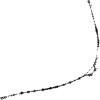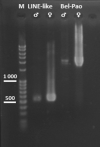Accumulation of retrotransposons contributes to W chromosome differentiation in the willow beauty Peribatodes rhomboidaria (Lepidoptera: Geometridae)
- PMID: 36631492
- PMCID: PMC9834309
- DOI: 10.1038/s41598-023-27757-3
Accumulation of retrotransposons contributes to W chromosome differentiation in the willow beauty Peribatodes rhomboidaria (Lepidoptera: Geometridae)
Abstract
The W chromosome of Lepidoptera is typically gene-poor, repeat-rich and composed of heterochromatin. Pioneering studies investigating this chromosome reported an abundance of mobile elements. However, the actual composition of the W chromosome varies greatly between species, as repeatedly demonstrated by comparative genomic hybridization (CGH) or fluorescence in situ hybridization (FISH). Here we present an analysis of repeats on the W chromosome in the willow beauty, Peribatodes rhomboidaria (Geometridae), a species in which CGH predicted an abundance of W-enriched or W-specific sequences. Indeed, comparative analysis of male and female genomes using RepeatExplorer identified ten putative W chromosome-enriched repeats, most of which are LTR or LINE mobile elements. We analysed the two most abundant: PRW LINE-like and PRW Bel-Pao. The results of FISH mapping and bioinformatic analysis confirmed their enrichment on the W chromosome, supporting the hypothesis that mobile elements are the driving force of W chromosome differentiation in Lepidoptera. As the W chromosome is highly underrepresented in chromosome-level genome assemblies of Lepidoptera, this recently introduced approach, combining bioinformatic comparative genome analysis with molecular cytogenetics, provides an elegant tool for studying this elusive and rapidly evolving part of the genome.
© 2023. The Author(s).
Conflict of interest statement
The authors declare no competing interests.
Figures






Similar articles
-
The genome sequence of the Willow Beauty, Peribatodes rhomboidaria (Denis & Schiffermüller, 1775).Wellcome Open Res. 2023 Jun 2;8:233. doi: 10.12688/wellcomeopenres.19479.1. eCollection 2023. Wellcome Open Res. 2023. PMID: 38249957 Free PMC article.
-
Degenerated, Undifferentiated, Rearranged, Lost: High Variability of Sex Chromosomes in Geometridae (Lepidoptera) Identified by Sex Chromatin.Cells. 2021 Aug 28;10(9):2230. doi: 10.3390/cells10092230. Cells. 2021. PMID: 34571879 Free PMC article.
-
Codling moth cytogenetics: karyotype, chromosomal location of rDNA, and molecular differentiation of sex chromosomes.Genome. 2005 Dec;48(6):1083-92. doi: 10.1139/g05-063. Genome. 2005. PMID: 16391677
-
[Cytogenetics and application in domesticated silkworm Bombyx mori].Yi Chuan. 2006 Sep;28(9):1167-72. doi: 10.1360/yc-006-1167. Yi Chuan. 2006. PMID: 16963430 Review. Chinese.
-
Sex chromosomes and sex determination in Lepidoptera.Sex Dev. 2007;1(6):332-46. doi: 10.1159/000111765. Epub 2008 Jan 18. Sex Dev. 2007. PMID: 18391545 Review.
Cited by
-
Discovery of new chromosomal markers through repeatome analysis of Caryophyllaeus laticeps (Caryophyllidea).Parasitol Res. 2025 Jul 18;124(7):84. doi: 10.1007/s00436-025-08530-z. Parasitol Res. 2025. PMID: 40679658 Free PMC article.
-
The genome sequence of the Willow Beauty, Peribatodes rhomboidaria (Denis & Schiffermüller, 1775).Wellcome Open Res. 2023 Jun 2;8:233. doi: 10.12688/wellcomeopenres.19479.1. eCollection 2023. Wellcome Open Res. 2023. PMID: 38249957 Free PMC article.
-
Expansion of satellite DNAs derived from transposable elements in beetles with reduced diploid numbers.Heredity (Edinb). 2025 Aug 24. doi: 10.1038/s41437-025-00790-w. Online ahead of print. Heredity (Edinb). 2025. PMID: 40849517
References
Publication types
MeSH terms
Substances
LinkOut - more resources
Full Text Sources
Research Materials

